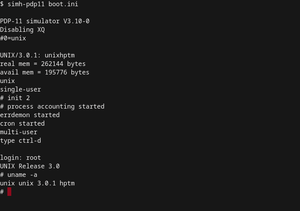Overview and History of Unix
– Unix is a family of multitasking, multi-user computer operating systems.
– It was developed in 1969 at the Bell Labs research center by Ken Thompson, Dennis Ritchie, and others.
– Unix was initially intended for use inside the Bell System but was later licensed to outside parties.
– Various academic and commercial Unix variants were developed by vendors such as BSD, Microsoft, Sun Microsystems, HP/HPE, and IBM.
– The Open Group owns the Unix trademark and allows its use for certified operating systems that comply with the Single UNIX Specification.
– Unix originated from the withdrawal of researchers from the Multics project in the mid-1960s.
– Ken Thompson, Dennis Ritchie, Douglas McIlroy, and Joe Ossanna started a new project to reimplement their experiences on a smaller scale.
– The operating system was initially named ‘Unics’ as a pun on ‘Multics’ and later became ‘Unix.’
– Version 4 Unix was rewritten in C in 1973, making it more suitable for porting.
– Unix gained popularity in academic circles and led to large-scale adoption by commercial startups, resulting in the fragmentation of Unix into multiple systems.
Characteristics and Influence of Unix
– Unix systems have a modular design known as the Unix philosophy.
– The operating system provides a set of simple tools, each performing a limited, well-defined function.
– Communication is facilitated through a unified and inode-based filesystem and inter-process communication using pipes.
– Complex workflows are achieved by combining tools through shell scripting and a command language.
– Unix was the first portable operating system, written mostly in the C programming language.
– Unix was initially designed as a platform for programmers rather than non-programmers.
– Its portability, multi-tasking, and multi-user capabilities led to its recognition as a potential universal operating system.
– The Unix environment and client-server program model played a crucial role in the development of the Internet and the shift towards network-centered computing.
– Unix and the C programming language were widely distributed to government and academic institutions, leading to their porting to various machine families.
– Unix became the operating system of choice for over 90% of the world’s top 500 fastest supercomputers.
Standards and Components of Unix
– POSIX, published in 1988, provided a common baseline for all operating systems, based on the structure of major Unix variants.
– The Common Open Software Environment (COSE) initiative eventually became the Single UNIX Specification (SUS) administered by The Open Group.
– The Open Group and IEEE formed the Austin Group in 1998 to define POSIX and the Single UNIX Specification.
– The COSE initiative and POSIX helped establish open operating system standards.
– The Common Desktop Environment (CDE) was part of the COSE initiative.
– Unix system composed of several components.
– Development environment, libraries, documents, and source code included.
– Kernel handles memory management, process scheduling, system calls, etc.
– Development environment includes text editor, C language compiler, assembler, linker.
– Object-code libraries and system library with C run-time support.
– Other languages and tools are also included.
Commands and Syntax in Unix
– Shell as the primary user interface.
– Core toolkit of Unix command set, including grep, find, and others.
– System utilities for administrative tasks.
– User utilities for environment management.
– Document formatting tools for document preparation and typesetting.
– Unix introduced a powerful programming paradigm called coroutines.
– Shorthand syntax for creating modular chains of producer-consumer processes (pipelines).
– Inspired the development of command-line interpreters in later systems.
– Focus on newline-delimited text for file formats.
– Textual shell command scripts used for system configuration.
Impact and Branding of Unix
– Unix had a significant impact on other operating systems.
– Interactivity, availability at a nominal fee for educational use, adaptability, and running on inexpensive hardware contributed to its reputation.
– Unix popularized the simplified file model treating all files as byte arrays.
– Hierarchical file system with nested subdirectories introduced by Unix.
– Command interpreter as a separate program, allowing customization and addition of new commands.
– Unix used text as the common representation for file formats.
– Unix programming interface became the basis for POSIX standard.
– C programming language spread beyond Unix and became ubiquitous.
– Unix-like systems such as Linux and BSD Unix filled market needs traditionally served by proprietary Unix systems.
– Unix has been used as a brand name for various products in different countries.
– Unix is known for its portability across a range of hardware.
– The stability of Unix lies in its software environment, not the hardware architecture.
– Unix programs can easily move into the next generation of hardware.
– Unix was created by software developers for software developers.
– The Open Group certifies UNIX systems based on the Single UNIX Specification.
– Licensed UNIX systems include AIX, EulerOS, HP-UX, Inspur K-UX, IRIX, macOS, Solaris, Tru64 UNIX, and z/OS.
– Representation of Unix-like systems is denoted by Un*x, *NIX, and *N?X.
– Usage and plural forms of UNIX vary, with UNIX being used as an adjective followed by a generic term.
– The trademark and portability of UNIX have had legal and technical implications.
Unix (/ˈjuːnɪks/, YOO-niks; trademarked as UNIX) is a family of multitasking, multi-user computer operating systems that derive from the original AT&T Unix, whose development started in 1969 at the Bell Labs research center by Ken Thompson, Dennis Ritchie, and others.
 | |
 Unix System III running on a PDP-11 simulator | |
| Developer | Ken Thompson, Dennis Ritchie, Brian Kernighan, Douglas McIlroy, and Joe Ossanna at Bell Labs |
|---|---|
| Written in | C and assembly language |
| OS family | Unix |
| Source model | Historically proprietary software, while some Unix projects (including BSD family and illumos) are open-source |
| Initial release | Development started in 1969 First manual published internally in November 1971 Announced outside Bell Labs in October 1973 |
| Available in | English |
| Kernel type | Varies; monolithic, microkernel, hybrid |
| Influenced by | CTSS, Multics |
| Default user interface | Command-line interface and Graphical (Wayland and X Window System; Android SurfaceFlinger; macOS Quartz) |
| License | Varies; some versions are proprietary, others are free/open-source software |
| Official website | www |
Initially intended for use inside the Bell System, AT&T licensed Unix to outside parties in the late 1970s, leading to a variety of both academic and commercial Unix variants from vendors including University of California, Berkeley (BSD), Microsoft (Xenix), Sun Microsystems (SunOS/Solaris), HP/HPE (HP-UX), and IBM (AIX). In the early 1990s, AT&T sold its rights in Unix to Novell, which then sold the UNIX trademark to The Open Group, an industry consortium founded in 1996. The Open Group allows the use of the mark for certified operating systems that comply with the Single UNIX Specification (SUS).
Early versions of Unix ran on PDP-11 computers.
Unix systems are characterized by a modular design that is sometimes called the "Unix philosophy". According to this philosophy, the operating system should provide a set of simple tools, each of which performs a limited, well-defined function. A unified and inode-based filesystem and an inter-process communication mechanism known as "pipes" serve as the main means of communication, and a shell scripting and command language (the Unix shell) is used to combine the tools to perform complex workflows.
Unix distinguishes itself from its predecessors as the first portable operating system: almost the entire operating system is written in the C programming language, which allows Unix to operate on numerous platforms.
1912 NW 143rd Ave #24,
Portland, OR 97229, USA